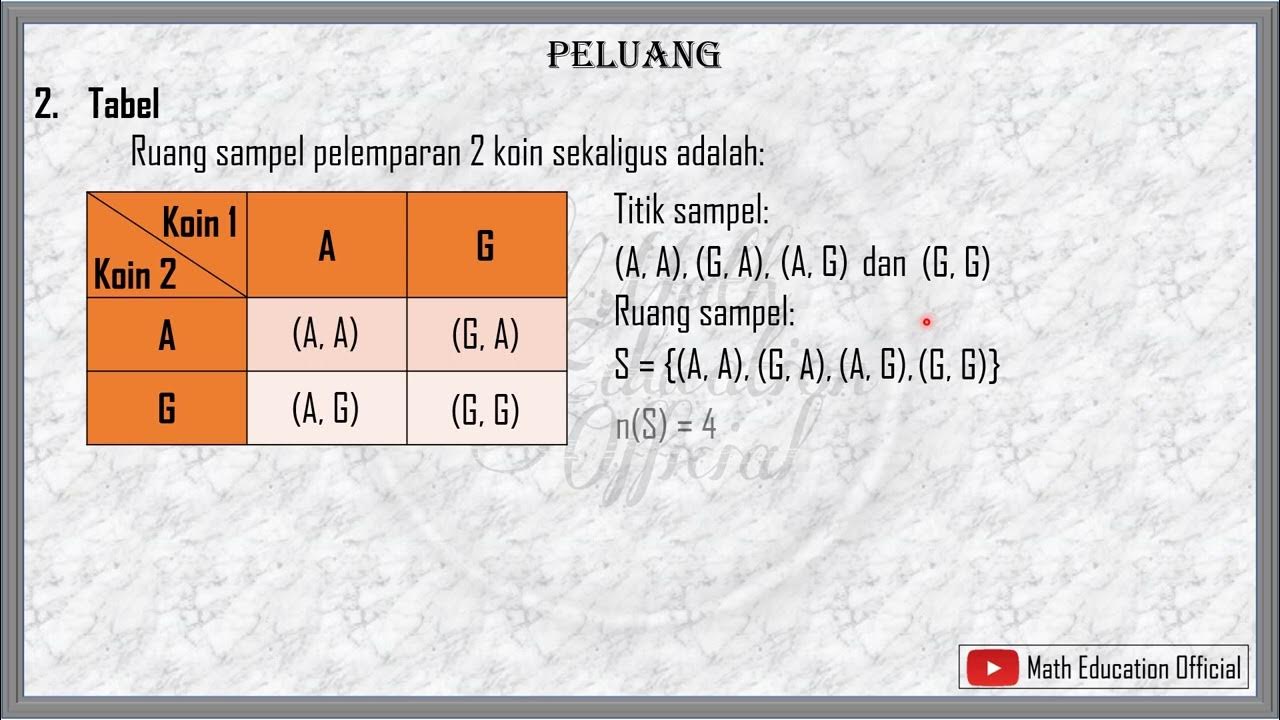Materi Peluang Kelas IX SMP
Summary
TLDRIn this educational video, Hafiz and others explain the fundamentals of probability, focusing on sample spaces, sample points, and events. They illustrate these concepts with examples such as rolling a die, flipping coins, and drawing cards from a deck. The lesson also covers calculating probabilities, complementary events, and expected frequency (or expectation). Through multiple examples, the video aims to make these concepts more accessible, helping viewers understand how to calculate the likelihood of various outcomes in simple experiments and the role of expectation in repeated trials.
Takeaways
- 😀 Sample space is the set of all possible outcomes from an experiment.
- 😀 A sample point refers to each individual outcome within the sample space.
- 😀 An event is a subset of the sample space, and its size is denoted as n(S).
- 😀 For a six-sided die, the sample space consists of {1, 2, 3, 4, 5, 6}.
- 😀 Odd outcomes on a die (1, 3, 5) form an event, with 3 favorable outcomes.
- 😀 When flipping two coins, the sample space can be represented by {AA, AG, GA, GG}.
- 😀 Probability is the ratio of favorable outcomes (n(A)) to total outcomes (n(S)).
- 😀 The probability of getting two heads and one tail when tossing three coins is 3/8.
- 😀 The complement of an event A is the event that A does not occur, denoted as A'.
- 😀 The probability of an event and its complement always add up to 1 (P(A) + P(A') = 1).
- 😀 Expected frequency (or expectation) is calculated as the probability of an event multiplied by the number of trials (n).
Q & A
What is a sample space in probability?
-A sample space is the set of all possible outcomes that could result from an experiment. It encompasses every possible result of the experiment.
What is a sample point?
-A sample point refers to an individual outcome or element within the sample space. Each sample point represents a possible result from the experiment.
What does 'n(S)' represent in probability theory?
-The notation 'n(S)' represents the number of elements in the sample space, essentially the total number of possible outcomes for an experiment.
What is an event or occurrence in probability?
-An event is a subset of the sample space, consisting of one or more outcomes. It is the specific result or group of results that we are interested in.
How is the sample space for a single six-sided die roll defined?
-The sample space for a single six-sided die roll consists of the set {1, 2, 3, 4, 5, 6}, representing each possible face that could land face-up.
How do you calculate the probability of an event?
-The probability of an event is calculated by dividing the number of favorable outcomes (n(A)) by the total number of possible outcomes (n(S)). The formula is P(A) = n(A) / n(S).
What is the probability of getting an odd number when rolling a six-sided die?
-The probability of rolling an odd number is 3/6, or 1/2, because there are three odd numbers (1, 3, 5) on the die and six possible outcomes in total.
What is the complement of an event in probability?
-The complement of an event A, denoted as A' or A complement, refers to the event where the outcome is not A. The probability of the complement is calculated as P(A') = 1 - P(A).
What does 'n(A)' represent in probability calculations?
-The notation 'n(A)' represents the number of favorable outcomes for event A. It is the count of the specific outcomes that align with the event being analyzed.
How is the expected frequency or expectation calculated?
-The expected frequency, denoted as E(A), is calculated by multiplying the probability of event A by the number of trials (n). The formula is E(A) = P(A) * n.
Outlines

Cette section est réservée aux utilisateurs payants. Améliorez votre compte pour accéder à cette section.
Améliorer maintenantMindmap

Cette section est réservée aux utilisateurs payants. Améliorez votre compte pour accéder à cette section.
Améliorer maintenantKeywords

Cette section est réservée aux utilisateurs payants. Améliorez votre compte pour accéder à cette section.
Améliorer maintenantHighlights

Cette section est réservée aux utilisateurs payants. Améliorez votre compte pour accéder à cette section.
Améliorer maintenantTranscripts

Cette section est réservée aux utilisateurs payants. Améliorez votre compte pour accéder à cette section.
Améliorer maintenantVoir Plus de Vidéos Connexes

Mengenal Ruang Sampel, Titik Sampel dan Kejadian

MENENTUKAN RUANG SAMPEL DAN TITIK SAMPEL PELUANG PART 1

Percobaan, Ruang Sampel dan Kejadian ||Materi, Soal & Pembahasan||

BELAJAR DARI RUMAH (MATEMATIKA MATERI PELUANG KELAS 8, LENGKAP CONTOH SOAL DAN PEMBAHASAN)

1. RUANG SAMPEL - PELUANG - KELAS 8 SMP

Peluang, Peluang kejadian, frekuensi harapan, peluang komplemen
5.0 / 5 (0 votes)
